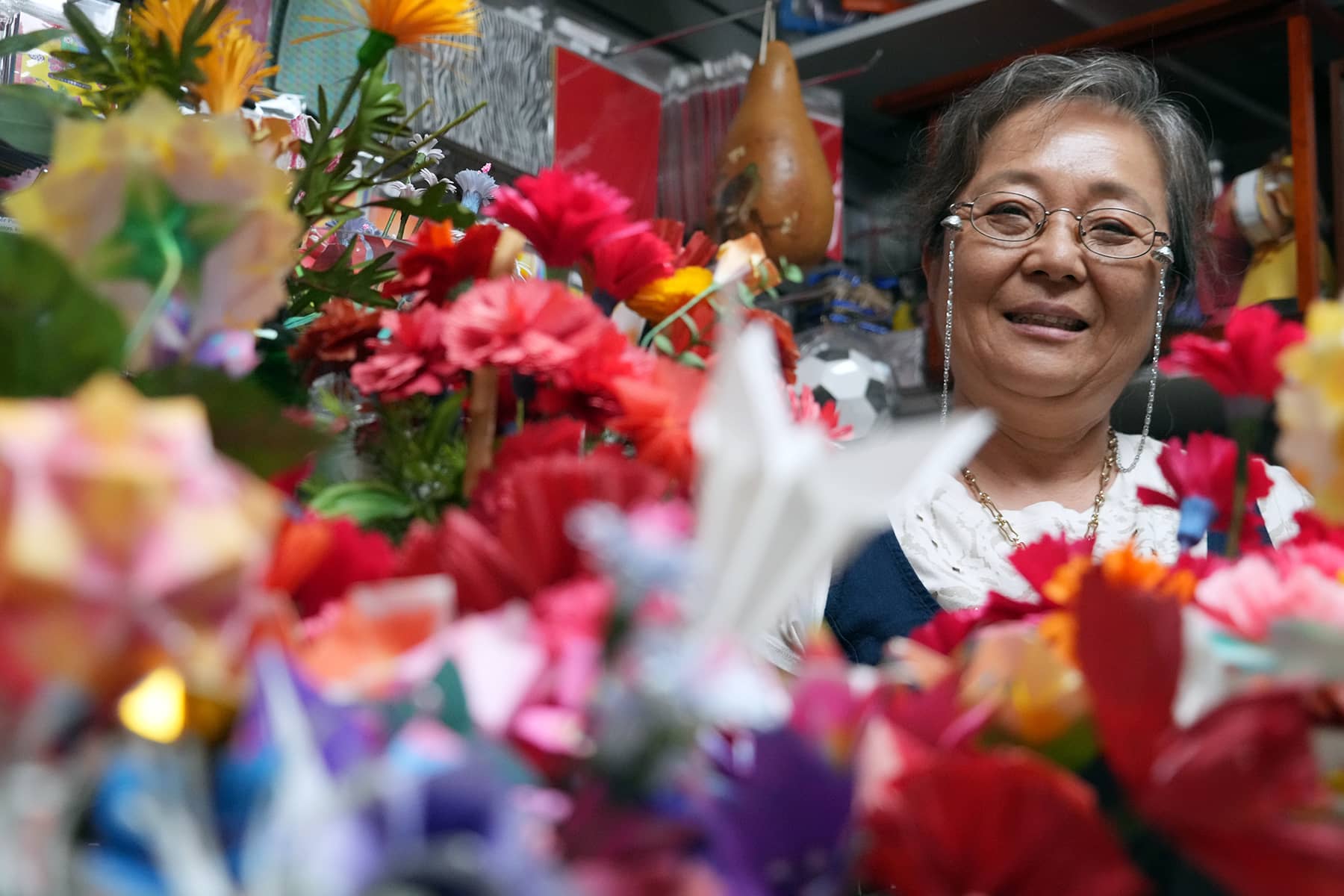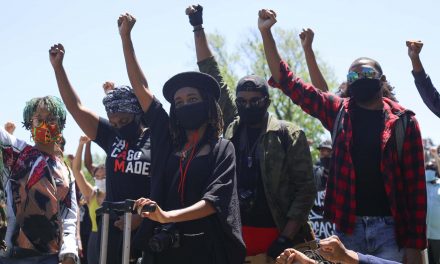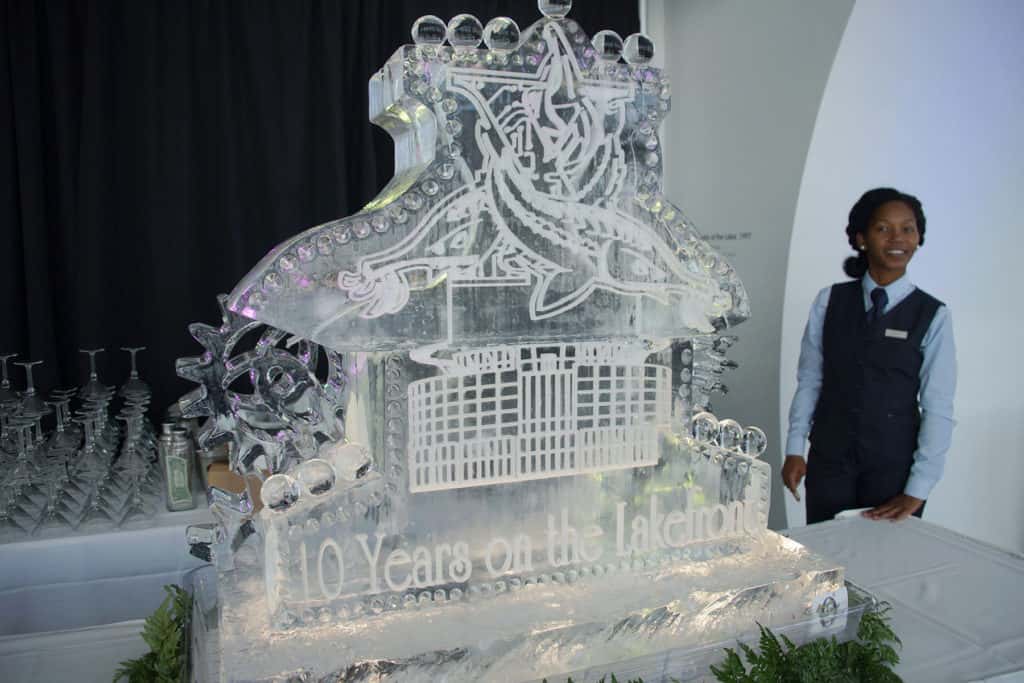
As an advocate for preserving and celebrating Korean cultural heritage, SeonJoo So Oh faced many challenges in life with courage and determination along her journey from Seoul to Milwaukee.
Born as the eldest of six siblings, SeonJoo was raised in a large, close-knit family where her role was vital in helping her parents.
“Being the oldest sister, I always had to help with my mother’s work,” said SeonJoo. “Our family was not wealthy, so we struggled every day just to find enough food.”
SeonJoo’s early experiences of hardship motivated her to pursue education with a sense of purpose. That ambition, to make a tangible difference in the community, would later guide her approach to preserving her heritage.
“My first major in college was agriculture, because producing more food was my goal,” said SeonJoo. “I wanted to become a scientist and contribute to solving food scarcity issues.”
When she was born, SeonJoo’s family lived in a rental house and had to move every year to a different place. Back then, there were large apartment buildings in South Korea where people rented by the room.
“We lived with my paternal grandmother, who always cared for me and showed me affection while my parents were busy. Those were good times. As I grew older, I found myself missing my grandmother more and more,” said SeonJoo. “My grandmother was born in 1905 and lived for 98 years. She was like a living history book, always sharing stories from Korea’s past. She grew up in the southwest part of the peninsula in Jeollabuk Province (전라북도) in the city of Jeonju (전주), considered the birthplace of bibimbap (비빔밥). The region is more rural and agricultural, with fewer mountains.”
When her grandmother was young, Korea was under Imperial Japanese rule. People could not keep their own supply of food, and were required to provide the harvest to the Japanese government for redistribution. That meant they got little if anything in return.
“From her, I inherited a deep sense of patriotism. She believed strongly in the importance of Korea’s independence and instilled that belief in me,” said SeonJoo. “She raised me with a strong focus on Korean traditions. She emphasized the value of our culture, especially in contrast to the negative perceptions the Japanese imposed on us.”
Traditional Korean fermented ingredients like soy sauce (ganjang 간장), soybean paste (doenjang 된장), and the red chili paste (gochujang 고추장) used in kimchi (김치), can take more than a year to ferment. Along with the Korean cuisine that contained them, foreigners like the Japanese often looked down on the food due to their strong garlic smell.
“I was always drawn to the science behind these food preparation traditions. I eventually applied to study agricultural chemistry, where I could explore the benefits of our ancient methods,” said SeonJoo. “My goal was to develop more refined, safe, and well-structured fermentation processes, preserving the essence of our culture while enhancing the food’s quality.”
During her college years, she dreamed of becoming a scientist. Unfortunately, that conflicted with the reality of South Korea during the 1980s. Its society and most companies offered limited opportunities for women to find high-level professional jobs.
“Despite the challenges, I worked hard to become the best I could be. I believed that if I improved my abilities, eventually someone would recognize my talent. Then, my gender would not matter,” said SeonJoo. “I was always dedicated to my studies, which made it difficult to socialize. But at the University, I met someone on the tennis court one day. He was two years ahead of me. As we spent more time together, our relationship grew closer. After a few years of dating, we got married.”
SeonJoo was aware her new husband had traditional views, but his attitude abruptly changed after their marriage. He believed that a woman’s place was in the home, raising children, while the man was the breadwinner.
“He asked me to stay at home for ten years, assuring me that after that period, I could pursue a job or further my education. I already had a Master’s Degree and wanted to work in a company or continue doing scientific research, but I agreed to his ten-year plan,” said SeonJoo. “I stayed at home, had a baby, and dedicated myself as a mother.”
Having a child changed SeonJoo completely. She was a highly educated woman, but her focus shifted entirely to her child. It was a strange experience for her on many levels, because she did not have toys growing up. With aspirations focused on the scientific community for so many years, SeonJoo now found joy in playing with her daughter, observing her development, and engaging in all the little moments like crying, laughing, and exploring the world.
“After having my second child, I decided to apply to another school to study early childhood education. During that time, my husband’s family didn’t approve of me going out of the house,” said SeonJoo. “South Korea had started offering at-home classes through radio broadcasts. I would record the lectures on cassette tapes, study from textbooks, and complete assignments by hand. Back then we didn’t have computers or even eMail. It was all before the Internet. I even typed my notes on an old typewriter – which was rare to have, decorated my reports with ribbons, and mailed them in from the post office.”
SeonJoo felt extremely rewarded to learn about child development from textbooks and apply that knowledge to experiences with her own children. As she watched them grow, she found that some behaviors matched what she studied, while others did not.
“I grew alongside my daughter and son, learning and practicing together,” said SeonJoo.
While she was still raising her kids, SeonJoo discovered the art of paper folding in South Korea after completing the early childhood education program.
Jongie-jupgi (종이 means “paper” and “jupgi” 접기 means “folding”) is similar to the Japanese art of origami. But unlike origami which uses only a single piece of paper, Jongie-jupgi has no limit, incorporating many pieces, cuts, and glue.
“During this time, I wanted to teach my children in a way that was enjoyable and free from the pressures of traditional Korean methods, like rote memorization or strict reading and writing,” said SeonJoo. “I didn’t like the idea of long, tedious lessons. So I incorporated fun activities like jongie-jupgi and other forms of art to make learning fun. And because I also loved science, I found that combining art and science created a wonderful learning experience for my kids.”
As she spent more time practicing art with her children, SeonJoo realized how much she enjoyed expressing her creative side. However, her schedule did not allow much time for her to fully focus on exploring her own artwork.
For a decade, SeonJoo dedicated herself to raising her children and staying at home as her husband demanded. He had promised that after ten years, she could then pursue her interests.
Instead, he changed his mind and refused to honor his promise.
“He wanted me to stay focused on raising our children, and prepare them to study abroad. So I began researching different countries like the Philippines, Australia, and Canada to find the best place for them to learn English and experience studying overseas,” said SeonJoo. “Eventually, I chose the United States because it offered more opportunities. I also found that in America, parents who were enrolled at a state university had an easier time to send their children to public schools.”
SeonJoo reviewed several regions, including the West Coast, East Coast, and the Midwest. Many Koreans lived in California, New York, and New Jersey. But as someone interested in science, she was concerned about the risk of earthquakes in California. And, the East Coast seemed too expensive. The Midwest felt like the perfect fit.
“My husband’s plan was to send our children off by themselves. But I said they needed a parent to help guide and protect them in such a different environment. That was true and how I felt. But I also saw it as an opportunity to reclaim my own life, my own identity, and pursue the things in life that I wanted,” said SeonJoo. “My husband had denied me a lot of freedom to keep his control over my life. So in 2006, I decided to study abroad in the U.S. It became an adventure for both me and my kids.”
SeonJoo’s husband dropped off their children in Milwaukee a week after she had arrived. The following week he departed for South Korea, leaving the three to settle into Milwaukee alone.
SeonJoo began studying for a Master’s Degree in childhood education at the University of Wisconsin-Milwaukee. But it was not long before her husband changed his mind about letting his family stay abroad, and he had no intention to join them.
He demanded that SeonJoo quit her studies and return with him to Seoul. She refused to do either. SeonJoo was left to navigate her new life, with her two kids, in a foreign country on her own. The transition to life in Milwaukee was not easy.
“About that time my father-in-law had passed away, and my mother-in-law was living alone. So my husband moved back to be with her, and they lived together in Seoul,” said SeonJoo. “I always had a good relationship with my mother-in-law and even with my grandmother-in-law. Her ancestor’s hometown was Gaesung (개성), which is now in North Korea.”
In the male-dominated hierarchy of Korean society at that time, when a woman got married, she was figuratively adopted into her husband’s family. The in-laws became her new primary family, often leading to a loss of close ties with her birth family.
As the first daughter-in-law, SeonJoo felt the burden of house chores. But her grandmother-in-law recognized her passion for learning and encouraged her to pursue more than just being a housewife. Her grandmother-in-law believed that continuous learning was essential, especially for a fulfilling life in old age.
“She was born in 1907, so when I moved to Milwaukee she was 99 years old. Before I left she pushed me to study more,” said SeonJoo. “I told her that if she passed away before I could catch a flight to return, it would be hard for me to cope. But she reassured me by saying, ‘Don’t worry about me. If I die, that will be easier for me to fly to you,’ meaning in spirit.”
SeonJoo’s first semester was particularly challenging. She struggled to keep up with her studies while also helping her children adjust. Her daughter was in eighth grade and her son was in sixth grade, both stumbling in their efforts to learn a new language as well.
They could read and understand English, but speaking was difficult. In the classroom, they had to translate everything in their minds, which made it hard to keep up. SeonJoo herself faced difficulties in understanding her professors and following the curriculum of her advanced classes.
“I would record lectures and listen to them later in the library, but I still had trouble understanding everything,” said SeonJoo. “To improve my English, I attended a speech therapy clinic at the university. One of the professors there had adopted two Korean girls, so she understood the challenges Koreans faced with English. She trained her students to become speech therapists, focused on helping non-native speakers.”
She attended the sessions for about three years, practicing her pronunciation and working hard to overcome language obstacles. Meanwhile, her children adapted to the local environment faster, interacting with American students regularly. However, her husband began to struggle with being away from his family, living alone in his mother’s house in Seoul.
“He wanted us to come back, and we argued about it over eMails and phone calls. It was a difficult time, but I felt that in Milwaukee we had more freedom and independence. In Korea, the husband is traditionally seen as the head of the family, but in America we could live more as equals without gender discrimination,” said SeonJoo. “Eventually, my husband stopped sending money to support us, which was a big problem since I needed to pay tuition as an F1 visa student.”
SeonJoo talked with her children and explained the need to make a lot of sacrifices to save money for essentials, cutting back on expenses like extracurricular activities. They supported her, even taking extra food home from school to help save costs.
Her student visa allowed for limited work, so SeonJoo found a job in the UW-Milwaukee cafeteria. She made Korean kimbap, similar to California sushi rolls, to support her family. The job also helped her learn more about American culture and better ways to navigate life in Milwaukee.
“Even though my husband struggled with his own issues and wasn’t very supportive, my children and I managed to find ways to make the best of our situation. Every day, I reminded myself that I wanted to grow and build a better life for us,” said SeonJoo. “In the end, I was able to finish my Master’s Degree. My mother-in-law secretly supported me, sending money without my husband knowing. That helped us get through many challenging times.”
SeonJoo said that her mind needed somewhere to focus to prevent dwelling on the problems with her marriage. She was always inspired to create beautiful crafts, and found that art was a powerful way to relieve stress. Especially through jongie-jupgi, SeonJoo felt a sense of achievement.
“During difficult times, art made it easier for me to forget my struggles. Sometimes I felt lost, unsure of the right path to take. But I discovered that stepping back and finding a new approach helped me find happiness. For me, that happiness came through art,” said SeonJoo. “I fell in love with paper folding — just a simple piece of paper can become something incredible. The process gave me so much joy.”
But the strain of living apart, and her husband’s possessive demands, eventually led to the dissolution of SeonJoo’s marriage. He filed for divorce and sent her the legal documents. Despite the language barrier and complications of distance, she was able to complete the required paperwork.
At that time, UW-Milwaukee provided free mental health services to prevent suicide. SeonJoo reached out for advice and care to process her feelings of frustration and hopelessness. The moment when she finally found relief in the ordeal came by way of a comment from a mental health counselor.
“I appreciated that he listened to my story, and offered me support. When we finished, he told me, ‘If I were in your shoes, moving to another country, trying to earn a living, raising kids, learning a new language, I’m not sure I could do it.’ That comment surprised me. It made me realize that I wasn’t useless. I had strength that I hadn’t recognized,” said SeonJoo.
Getting divorced in South Korea was still considered a significant social issue, especially for women. It often carried a stigma, as they were traditionally expected to maintain the family unit and prioritize their roles as wives and mothers.
SeonJoo lost connections to her first family by birth when she got married. She then lost connections to her second family by law when she got divorced. However, she was able to maintain a strong relationship with her ex-mother-in-law until she passed away.
“Even after the divorce, we stayed in touch through phone calls and eMails. When I remarried a Korean American man in Milwaukee – who had lost his first wife to liver cancer, my ex-mother-in-law continued to connect with me. I still called her ‘mom.’ She passed away last May at the age of 93,” said SeonJoo. “Although I couldn’t be there, I mourned her loss by wearing black for 49 days as a sign of respect.”
The mourning period lasts for 49 days, culminating in the 49th Day Rite. Known as Sije (사십구재) in Korean Buddhism, it is a significant ceremony rooted in beliefs about the afterlife and the journey of the soul.
The divorce and family deaths arrived as a string of hardships in those early years of SeonJoo’s life in Milwaukee. By then she had just applied for an E-2 visa to open her own business. It took many weeks for her application to get approved. While she waited, SeonJoo was unable to return to Seoul since her visa status was tied up in the process.
Under U.S. law, leaving the country while an application was pending would be interpreted as abandoning the application. That meant she could have lost her ability to continue living in Milwaukee, or even be blocked from returning.
“So I couldn’t visit Korea during that sad time. It was a difficult period. But my faith as a Christian helped me through it, even though the divorce left me emotionally and physically drained,” said SeonJoo. “I also relied on my Korean traditions and Confucian values as a lifeline. Above all else, I realized that family was my true anchor. I fought to keep my children and raise them, and they supported me during that challenging period, especially when they had to make tough decisions about their college paths and careers.”
As conditions in her life began to calm down and offer stability, SeonJoo wasted no time pursuing her many creative interests – with renewed excitement. She earned recognition for being an expert in jongie jupgi from the many workshops she taught to the Milwaukee public. Her work was also featured in art exhibitions across the city. However, Milwaukee’s Korean American community was much slower to be impressed and acknowledge her talent.
“Paper folding, the basis of my art, isn’t always considered a highly valued art form. There are certain rules and perceptions about what constitutes ‘key’ or ‘priceless’ art,” said SeonJoo. “But my focus has always been on teaching. I wanted to share the benefits of paper folding as a way to relieve stress, develop motor skills, and foster concentration and creativity.”
SeonJoo said that she never aimed to make her art into grand pieces like those of famous painters or sculptors. Her work was rooted in a long tradition of Korean art using handmade Korean paper. She enjoyed using the paper to create something new, something that most Americans were unfamiliar with. When they saw her work, they were often surprised and fascinated.
After the COVID-19 pandemic began to hit Milwaukee in early 2020, people in the city, the nation, and the world, went into isolation. The lockdown provided SeonJoo with an unexpected opportunity to focus entirely on her art.
“All my appointments with MPS and other commitments were canceled, so I stayed in my studio and worked. It became a safe haven for me. With no distractions, I could concentrate entirely on perfecting my craft,” said SeonJoo. “Before that, I would create small pieces and set them aside, thinking that one day I would complete a larger project. During the pandemic, I took the time to assemble all those saved pieces into significant works of art.”
By 2022, her reputation had skyrocketed with awards, professional recognitions, exhibits in Wisconsin and Illinois, and new opportunities to fulfill her mission. It all came after 18 years of hard work, each and every day, and persevering regardless of the insurmountable obstacles in her path.
“I had a dream when I decided to live here. I wanted to be a good friend to America, to share Korean culture, Korean art, and Korean tradition. It was my mission to pass on the values and lessons I learned from my ancestors to the next generation,” SeonJoo added. “I was born in Seoul and lived there for much of my life before moving to Milwaukee, where I’ve spent almost two decades. Now I can be a bridge between America and Korea. I am living my dream.”
- Exploring Korea: Stories from Milwaukee to the DMZ and across a divided peninsula
- A pawn of history: How the Great Power struggle to control Korea set the stage for its civil war
- Names for Korea: The evolution of English words used for its identity from Gojoseon to Daehan Minguk
- SeonJoo So Oh: Living her dream of creating a "folded paper" bridge between Milwaukee and Korean culture
- A Cultural Bridge: Why Milwaukee needs to invest in a Museum that celebrates Korean art and history
- Korean diplomat joins Milwaukee's Korean American community in celebration of 79th Liberation Day
- John T. Chisholm: Standing guard along the volatile Korean DMZ at the end of the Cold War
- Most Dangerous Game: The golf course where U.S. soldiers play surrounded by North Korean snipers
- Triumph and Tragedy: How the 1988 Seoul Olympics became a battleground for Cold War politics
- Dan Odya: The challenges of serving at the Korean Demilitarized Zone during the Vietnam War
- The Korean Demilitarized Zone: A border between peace and war that also cuts across hearts and history
- The Korean DMZ Conflict: A forgotten "Second Chapter" of America's "Forgotten War"
- Dick Cavalco: A life shaped by service but also silence for 65 years about the Korean War
- Overshadowed by conflict: Why the Korean War still struggles for recognition and remembrance
- Wisconsin's Korean War Memorial stands as a timeless tribute to a generation of "forgotten" veterans
- Glenn Dohrmann: The extraordinary journey from an orphaned farm boy to a highly decorated hero
- The fight for Hill 266: Glenn Dohrmann recalls one of the Korean War's most fierce battles
- Frozen in time: Rare photos from a side of the Korean War that most families in Milwaukee never saw
- Jessica Boling: The emotional journey from an American adoption to reclaiming her Korean identity
- A deportation story: When South Korea was forced to confront its adoption industry's history of abuse
- South Korea faces severe population decline amid growing burdens on marriage and parenthood
- Emma Daisy Gertel: Why finding comfort with the "in-between space" as a Korean adoptee is a superpower
- The Soul of Seoul: A photographic look at the dynamic streets and urban layers of a megacity
- The Creation of Hangul: A linguistic masterpiece designed by King Sejong to increase Korean literacy
- Rick Wood: Veteran Milwaukee photojournalist reflects on his rare trip to reclusive North Korea
- Dynastic Rule: Personality cult of Kim Jong Un expands as North Koreans wear his pins to show total loyalty
- South Korea formalizes nuclear deterrent strategy with U.S. as North Korea aims to boost atomic arsenal
- Tea with Jin: A rare conversation with a North Korean defector living a happier life in Seoul
- Journalism and Statecraft: Why it is complicated for foreign press to interview a North Korean defector
- Inside North Korea’s Isolation: A decade of images show rare views of life around Pyongyang
- Karyn Althoff Roelke: How Honor Flights remind Korean War veterans that they are not forgotten
- Letters from North Korea: How Milwaukee County Historical Society preserves stories from war veterans
- A Cold War Secret: Graves discovered of Russian pilots who flew MiG jets for North Korea during Korean War
- Heechang Kang: How a Korean American pastor balances tradition and integration at church
- Faith and Heritage: A Pew Research Center's perspective on Korean American Christians in Milwaukee
- Landmark legal verdict by South Korea's top court opens the door to some rights for same-sex couples
- Kenny Yoo: How the adversities of dyslexia and the war in Afghanistan fueled his success as a photojournalist
- Walking between two worlds: The complex dynamics of code-switching among Korean Americans
- A look back at Kamala Harris in South Korea as U.S. looks ahead to more provocations by North Korea
- Jason S. Yi: Feeling at peace with the duality of being both an American and a Korean in Milwaukee
- The Zainichi experience: Second season of “Pachinko” examines the hardships of ethnic Koreans in Japan
- Shadows of History: South Korea's lingering struggle for justice over "Comfort Women"
- Christopher Michael Doll: An unexpected life in South Korea and its cross-cultural intersections
- Korea in 1895: How UW-Milwaukee's AGSL protects the historic treasures of Kim Jeong-ho and George C. Foulk
- "Ink. Brush. Paper." Exhibit: Korean Sumukhwa art highlights women’s empowerment in Milwaukee
- Christopher Wing: The cultural bonds between Milwaukee and Changwon built by brewing beer
- Halloween Crowd Crush: A solemn remembrance of the Itaewon tragedy after two years of mourning
- Forgotten Victims: How panic and paranoia led to a massacre of refugees at the No Gun Ri Bridge
- Kyoung Ae Cho: How embracing Korean heritage and uniting cultures started with her own name
- Complexities of Identity: When being from North Korea does not mean being North Korean
- A fragile peace: Tensions simmer at DMZ as North Korean soldiers cross into the South multiple times
- Byung-Il Choi: A lifelong dedication to medicine began with the kindness of U.S. soldiers to a child of war
- Restoring Harmony: South Korea's long search to reclaim its identity from Japanese occupation
- Sado gold mine gains UNESCO status after Tokyo pledges to exhibit WWII trauma of Korean laborers
- The Heartbeat of K-Pop: How Tina Melk's passion for Korean music inspired a utopia for others to share
- K-pop Revolution: The Korean cultural phenomenon that captivated a growing audience in Milwaukee
- Artifacts from BTS and LE SSERAFIM featured at Grammy Museum exhibit put K-pop fashion in the spotlight
- Hyunjoo Han: The unconventional path from a Korean village to Milwaukee’s multicultural landscape
- The Battle of Restraint: How nuclear weapons almost redefined warfare on the Korean peninsula
- Rejection of peace: Why North Korea's increasing hostility to the South was inevitable
- WonWoo Chung: Navigating life, faith, and identity between cultures in Milwaukee and Seoul
- Korean Landmarks: A visual tour of heritage sites from the Silla and Joseon Dynasties
- South Korea’s Digital Nomad Visa offers a global gateway for Milwaukee’s young professionals
- Forgotten Gando: Why the autonomous Korean territory within China remains a footnote in history
- A game of maps: How China prepared to steal Korean history to prevent reunification
- From Taiwan to Korea: When Mao Zedong shifted China’s priority amid Soviet and American pressures
- Hoyoon Min: Putting his future on hold in Milwaukee to serve in his homeland's military
- A long journey home: Robert P. Raess laid to rest in Wisconsin after being MIA in Korean War for 70 years
- Existential threats: A cost of living in Seoul comes with being in range of North Korea's artillery
- Jinseon Kim: A Seoulite's creative adventure recording the city’s legacy and allure through art
- A subway journey: Exploring Euljiro in illustrations and by foot on Line 2 with artist Jinseon Kim
- Seoul Searching: Revisiting the first film to explore the experiences of Korean adoptees and diaspora
















































